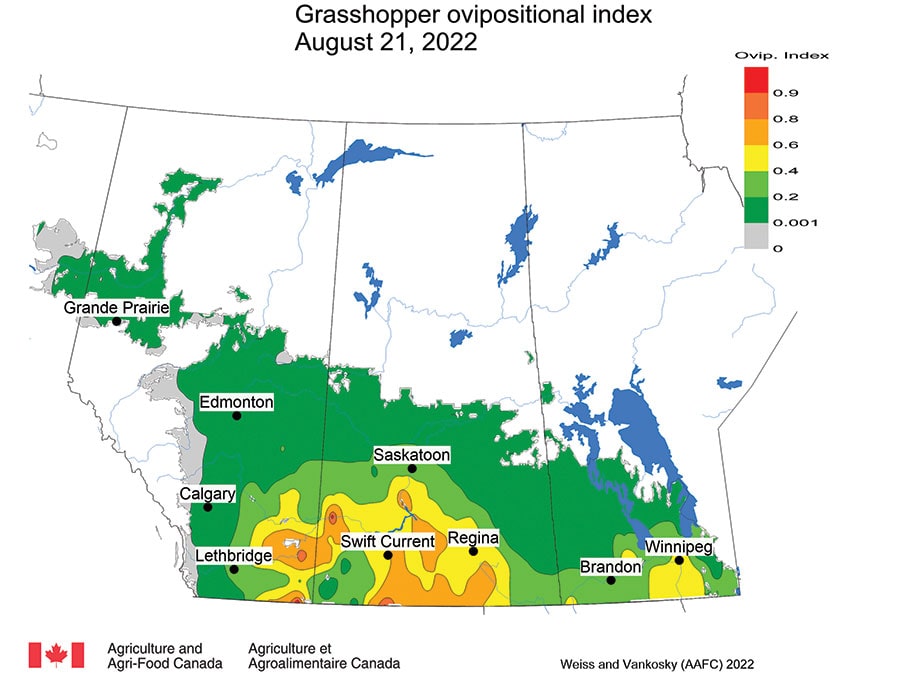Sign up to help the Prairie Pest Monitoring Network
Key result:
The Prairie Pest Monitoring Network (PPMN) provides forecasts, risk maps and monitoring protocols for crop pest insects across Western Canada. It also provides a free weekly update during the growing season. Anyone can subscribe at prairiepest.ca.
Project title, principal investigator:
“Coordinated monitoring of field crop insect pests in the Prairie Ecosystem” Meghan Vankosky, AAFC Saskatoon
Funding:
SaskCanola, Manitoba Canola Growers, Western Grains Research Foundation

Saskatchewan farmers who want to give permission for pest monitoring can use the QR code, which takes them to “Pest monitoring in Saskatchewan: Why it is important and how you can get involved” at saskatchewan.ca.
This project provides funding support for the Prairie Pest Monitoring Network (PPMN).
The PPMN is comprised of field crop entomologists who conduct research and actively monitor insect pest populations. It includes researchers from Agriculture and Agri-Food Canada, Manitoba Agriculture, Saskatchewan Ministry of Agriculture, Alberta Agriculture Forestry and Rural Economic Development, and university researchers. Industry stakeholders provide regular input including monitoring data in the summer and valuable insight at annual PPMN working group meetings.
A coordinated insect surveillance program for the Prairies first took shape in 1997. Since then, the PPMN has been involved in coordinating and conducting population monitoring of insect pests of field crops.
The PPMN conducts annual insect pest monitoring in oilseed, pulse and cereal crops to generate maps of regional pest distribution and relative abundance. It also develops and uses predictive models to help farmers and agronomists time pest scouting activities during the growing season. The PPMN communicates this information through weekly updates. These updates and other information are available online at prairiepest.ca. People can also sign up to receive weekly updates by email.
Farmer cooperation
Annual monitoring, especially of pests like cabbage seedpod weevil, pea leaf weevil and wheat midge, for example, requires in-field sampling. The PPMN relies on farmers to volunteer access to their properties for monitoring. Without volunteered field sites, the PPMN cannot collect enough samples across the Prairie region to estimate, with reasonable accuracy, changes in pest distribution and population density. In Manitoba and Alberta, farmers can volunteer their land for monitoring by contacting John Gavloski (john.gavloski@gov.mb.ca) and Shelley Barkley (shelley.barkley@gov.ab.ca), respectively. In Saskatchewan, farmers can sign up to volunteer their land online. Use the QR code on this page to find the sign up page.
2023 canola pest planning
The PPMN monitors several important pests of canola, including diamondback moth. Diamondback moth were quite low for most of the spring and summer, but populations grew quickly in August because of high daily temperatures. Diamondback moth is a migratory pest that does not survive winter conditions in Western Canada, so monitoring will begin again in spring 2023 for the arrival and growth of diamondback moth populations.
The final weekly update of 2022, posted August 26, included an update on grasshoppers, which can be an important pest of canola, especially as their densities increase. Grasshopper populations were quite high in some parts of the Prairies in 2022, with weather conditions optimal for fast grasshopper development and egg laying. Earlier egg laying (oviposition) can result in above-average production of eggs and increased overwintering survival of eggs. In 2022, model outputs indicate that oviposition rates were high across a large part of southern Prairies, extending from east of Lethbridge to Regina and north to Saskatoon (see the map). Farmers should scout early and often for grasshopper development in spring 2023, especially in areas where grasshoppers were plentiful in summer 2022.






